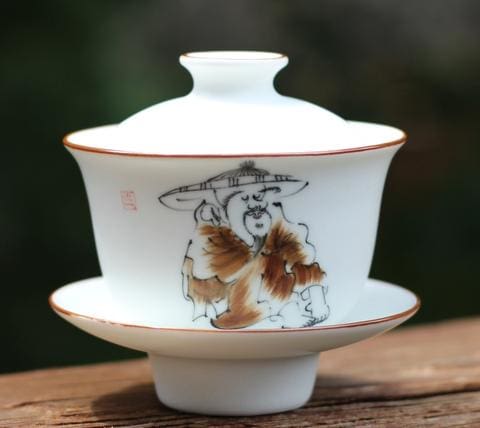
How to Drink Tea from a Gaiwan
Although the gaiwan remains the most widely preferred teaware for gongfu tea ceremonies, did you know that it can also be used more casually? Indeed, one reason it has retained such immense popularity for nearly a thousand years is that it possesses remarkable versatility, able to adapt perfectly to nearly any setting and need.

In celebration of this amazing piece of teaware, we’re going to discuss a more relaxed way to use the gaiwan, a way that upholds tradition and deepens one’s appreciation for tea without requiring some of the more formal elements of the gongfu ceremony.
One of the oldest forms of drinking tea is known as “grandpa style,” dating back to a time when tea was regarded almost exclusively as a medicine, a time that began nearly 6,000 years ago with its discovery by the legendary sage Shennong. To brew tea in this way, one need only pour some water over the tea leaves and then sip the infusion directly, much like how one might find green tea enjoyed today in Fujian.
But to characterize drinking tea from the gaiwan as “grandpa style” isn’t quite right. There’s something different about it, something more powerful.
While grandpa style is one of the most relaxed ways to enjoy tea, it can come at the cost of sacrificing certain elements of the tea drinking experience. Why? Because grandpa style doesn’t force us to pause, take notice, and absorb the experience — it doesn’t invite us in or demand our attention.
But when done properly, drinking tea from a gaiwan manages to do precisely these things.

First, you’ll want to fill your gaiwan approximately 1/4 to 1/2 with tea leaves, taking into consideration the size of the leaves and how tightly they’re rolled. The leaves will unravel and expand, after all, and they need room to grow, bloom, and breathe. For example, you’ll want to use a smaller amount of tightly rolled oolong leaves than you would a fluffier tea, such as white peony white tea.
Next, pour warm water over the tea leaves. Be sure that the water chosen is hot but also at a comfortable drinking temperature (a preference that can vary from person to person). And when the gaiwan is approximately 3/4 to 4/5 filled, place the lid on it.
When you are ready to drink the tea, place your left hand under the saucer and slowly lift the gaiwan, stopping when you can easily look down at it without involving your neck too much, for it is important to maintain a healthy posture — it promotes both attention and intention. Taking your right hand, pinch the top of the lid with your middle finger and thumb, securing the lid and preparing to manipulate it.
It is important to refrain from removing the lid, for doing so defeats the purpose of using the gaiwan and taking advantage of what it offers. Rather, tilt the lid gently into the water so that you can see some of the tea leaves.

At this point, take the time to pause for a moment. Smell the aromas emanating from the gaiwan, feeling free to even waft them upward with the help of the lid. Notice the tea leaves — their colors, how they move in the water and react to it, how some of them sit in the bottom of the bowl and others float at the top. Admire the infusion itself, marveling at its clarity, its color, or even the different bubbles that appear.
This is part of the experience, part of what it means to drink from the gaiwan.
When you’re ready, use the lid to ever so slightly brush the floating leaves away from the edge that you plan to use for sipping. You may need to do this several times until it looks just right, and once it does, use the lid to create a gap with the edge of the bowl, a gap that enables you to sip the infusion without any leaves getting in the way.
Sip the tea, but do it with intention, slowly. Allow the tea to give all that it has to offer, sipping multiple times out of appreciation, appreciation for the tea, for oneself, and for others.